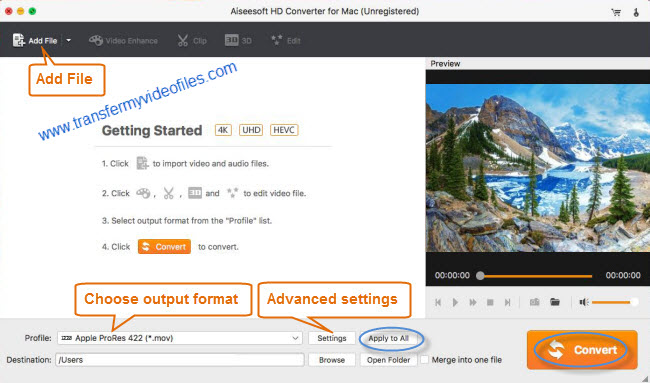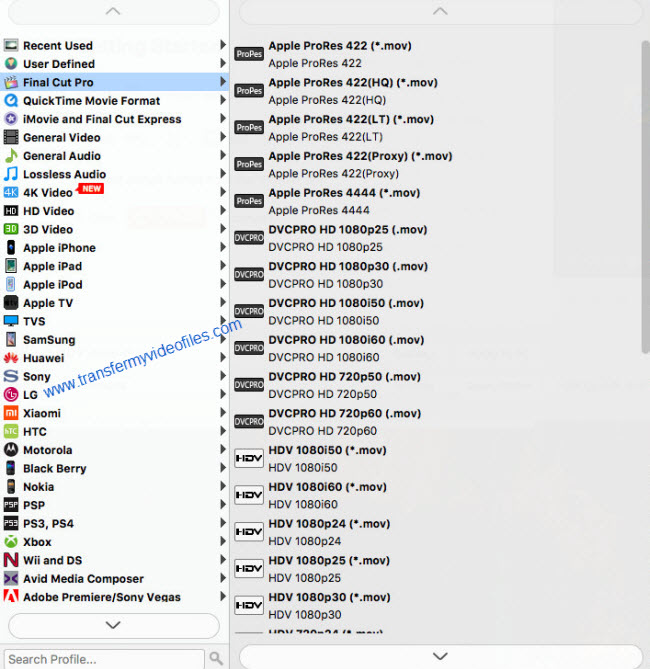If you are looking for a smooth way to edit Canon XF300/305 MXF files in Final Cut Pro X/7/6, you may wish to read this post. It introduces an easy-to-use and reliable converter to help you transcode Canon XF300/305 MXF files to ProRes for use in Final Cut Pro X/7/6 easily and directly.

How can I import Canon XF300 MXF files to FCP X for editing?
“I’m using FCP X and editing on a MacBook Pro OS X 10.9, 4 GB memory. I have video recordings from a Canon XF300 which shots footage in MXF format and not sure the best way to work with it. I manage to import the media but it keeps crashing the software when we try to play it. Anyone got any ideas about this? I heard from someone that I need to transcode the file before importing, if this is the case, what should I use?”
The MXF is a very processor heavy codec. It’s possible the computer doesn’t have enough horse power to play the clips. If you have to transcode the Canon XF300 MXF files, it should be to a ProRes codec. Read on to find a tutorial guiding you through the process of converting Canon XF300/305 MXF files to ProRes 422 for editing in FCP X or its former version FCP 6 and 7. This required third party software like HD Video Converter for Mac. You can download a free trail version here.

How to rewrap Canon XF300/305 MXF files to ProRes 422 for FCP 6/7/X?
Follow these steps:
Step 1: Run HD Video Converter for Mac as a professional Canon XF300/305 MXF to FCP Converter. When its main interface comes up, click ‘Add File’ to load source video to it.

Step 2: Select ‘Apple ProRes 422 (*.mov)’ as output format for opening with FCP X or FCP 6 and 7
From the Format bar, move to ‘Final Cut Pro’ catalogue, and select ‘Apple ProRes 422 (*.mov)’ as target format. Apple ProRes is the best suited editing codec for FCP X and its former version FCP 6 and FCP 7. When loading them into FCP (X), you needn’t wait for a long time for rendering. To create smaller files, transcode your source files to Apple ProRes 422 (LT).

Apple ProRes 422 – Higher quality than Apple ProRes 422 (LT);
Apple ProRes 422 (HQ) – Keep original video quality for editing in FCP;
Apple ProRes 422 (LT) – Get a smaller file sizes than Apple ProRes 422;
Apple ProRes 422 (Proxy) – SD levels – 480i/p and 576i/p. Used in offline workflows.
Apple ProRes 4444 – Edit and finish 4:4:4 material.
Important: If you’ve loaded a number of video clips to do batch conversion, please do remember ticking off ‘Apply to All’ option before you start.
Step 3: Adjust video and audio settings (for advanced users)
If necessary, you can click ‘Settings’ button and go to ‘Profiles Settings’ panel to modify video and audio settings like video encoder, resolution, video bit rate, frame rate, aspect ratio, audio encoder, sample rate, audio bit rate, and audio channels. 3D settings are also available.
Step 4: Click ‘Convert’ to start Canon XF300/305 MXF files to ProRes MOV conversion.
Step 5: Click ‘Open Folder’ to get generated ProRes QuickTime files for transferring and editing in Final Cut Pro X/7/6 with optimum performance.
Related posts
Why Adobe Premiere Pro CS6 can’t import MXF video files?
How can I import MXF footage into Avid Media Composer?
FCP 7 not recognizing my MXF file – convert MXF to ProRes
MXF and Vegas – How can I edit MXF video files in Sony Vegas?
